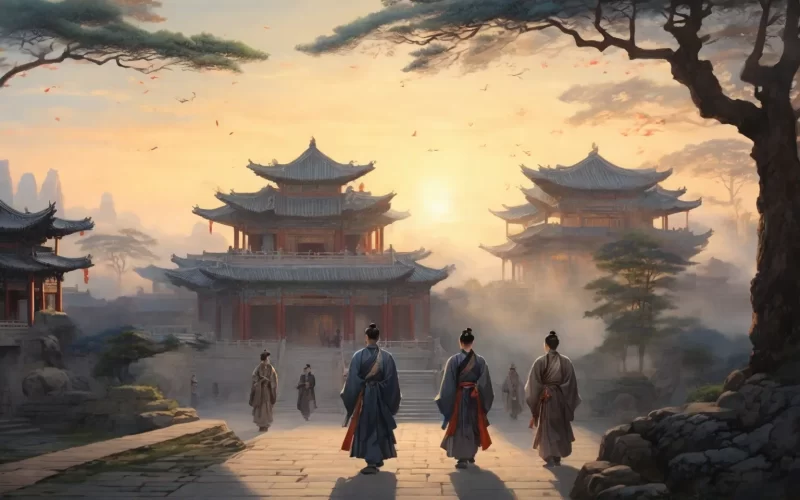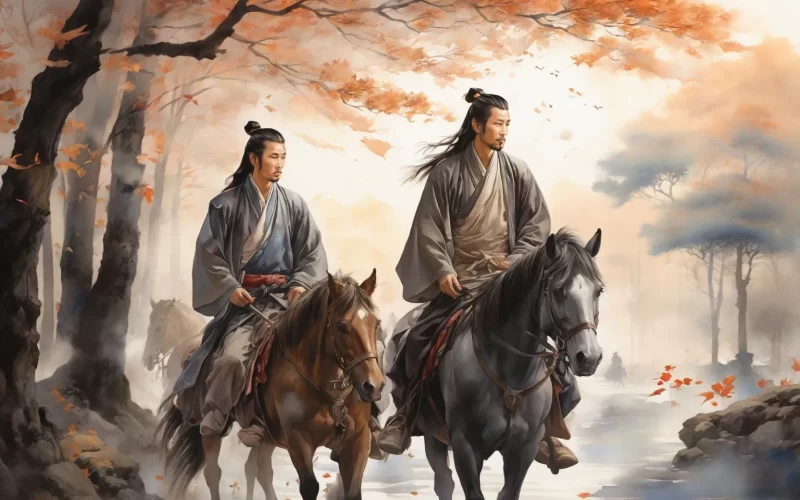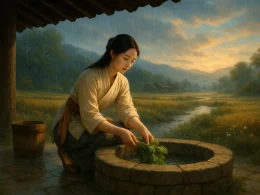Cock-crow, the Purple Road cold in the dawn;
Linnet songs, court roofs tinted with April;
At the Golden Gate morning bell, countless doors open,
And up the jade steps float a thousand officials
With flowery scabbards... Stars have gone down;
Willows are brushing the dew from the flags --
And, alone on the Lake of the Phoenix, a guest
Is chanting too well The Song of Bright Spring.
Original Poem:
「奉和中书舍人贾至早朝大明宫」
岑参
鸡鸣紫陌曙光寒, 莺啭皇州春色阑。
金阙晓钟开万户, 玉阶仙仗拥千官。
花迎剑佩星初落, 柳拂旌旗露未乾。
独有凤凰池上客, 阳春一曲和皆难。
Interpretation:
This is a palace tribute poem composed by Cen Can. During the Tang Dynasty, particularly in the flourishing High Tang period, the custom of writing palace poetry was prevalent. Scholars and poets were often summoned to the imperial court to attend morning assemblies or banquets, where they were asked to compose and exchange poems, praising the emperor's boundless grace and the empire’s prosperity. This particular poem was written by Cen Can during an early morning court assembly at Daming Palace. It serves both as a depiction of the court’s splendor and an expression of the poet’s admiration for the peaceful era of the High Tang, along with his own humble reflections on being part of the imperial court.
First Couplet:“鸡鸣紫陌曙光寒,莺啭皇州春色阑。”
The crowing of roosters echoes along the purple streets as dawn breaks with a hint of chill; in the imperial capital, orioles sing, heralding the fading spring.
The poem opens with a panoramic view of the capital before the morning court session. The rooster’s crow and the cold dawn establish the early hour of the assembly, while the singing orioles and the waning spring scenery capture the beauty of Chang’an as spring draws to a close. This couplet, with its broad perspective, paints a sweeping image of the imperial capital at daybreak, setting the poem’s grand tone.
Second Couplet:“金阙晓钟开万户,玉阶仙仗拥千官。”
The morning bells ring through the golden gates, opening wide to welcome all officials; on the jade steps, ceremonial guards stand in formation, surrounding countless courtiers.
Here, the focus shifts to the interior of the imperial palace, depicting the solemnity and grandeur of the morning court session. The bells resound through the palace, gates swing open, and officials file in with great ceremony. Images like "golden gates," "jade steps," and "immortal guards" highlight the majestic opulence of the imperial court, while also emphasizing the orderly governance of a prosperous age. This couplet directly presents the central court scene, transitioning smoothly from the broader exterior view of the first couplet.
Third Couplet:“花迎剑佩星初落,柳拂旌旗露未乾。”
Flowers greet the sword-wearing officials as the last stars fade from the sky; willow branches brush against fluttering banners, still wet with morning dew.
This couplet vividly portrays the officials’ procession to court. The clinking of swords and the waving banners signal the arrival of civil and military officials, while flowers and willow branches enhance the scene with springtime freshness. This blend of grandeur and natural beauty transforms the morning assembly into a dynamic and picturesque tableau, bringing the vibrant atmosphere of High Tang to life.
Fourth Couplet:“独有凤凰池上客,阳春一曲和皆难。”
Only the honored guest at Phoenix Pool can compose a "Song of Bright Spring" so exquisite that none can match it.
In this concluding couplet, Cen Can adopts a humble tone, alluding to the poetic exchange and directly referencing the poem’s purpose — to respond to a fellow court poet’s work. Phoenix Pool symbolizes the emperor’s audience hall, while the "Song of Bright Spring" represents refined, elegant poetry. Cen Can modestly claims that his own skills are far inferior, thereby both praising the recipient’s talent and subtly acknowledging his own participation in the poetic dialogue. This couplet serves as a graceful and tactful conclusion, embodying the elegance of palace poetic exchanges.
Overall Appreciation:
“Early Morning at Daming Palace” is a classic example of a palace tribute poem. Centered around the theme of early court assembly, the poem unfolds through a progressive series of visual scenes, vividly capturing the grandeur of the imperial capital and the prosperity of the High Tang era. It opens with a sweeping view, transitions into a richly detailed court scene, and ends with a self-effacing gesture, forming a structurally clear and orderly composition that reflects Cen Can’s mastery of regulated verse. Though the poem concludes with a humble disclaimer, it still conveys the poet’s quiet confidence and literary elegance. While written as part of a formal palace exchange, the poem’s rich diction and grand imagery make it a shining example of the majestic yet refined aesthetic of High Tang poetry.
Writing Characteristics:
- Clear theme with progressive development: The poem unfolds gradually, starting with a distant view, moving to closer details, then focusing on the procession of officials, and finally concluding with a humble reflection — a clear and layered progression.
- Elegant parallelism and ornate language: Every couplet is meticulously paired, and the diction is refined and luxurious, reflecting the formal beauty required in palace poetry.
- Strong spatial sense with dynamic and static imagery: The poem blends quiet morning scenery with lively official processions, balancing motion and stillness for a well-rounded depiction.
- Subtle humility with dignified self-restraint: The closing couplet’s self-effacing tone not only fits the decorum of palace poetry, but also hints at the poet’s own sense of literary accomplishment — modest yet confident.
Insights:
This poem highlights the unique aesthetic value of palace tribute poetry during the Tang Dynasty. It reminds us that literary creation is not only a means of personal expression but also a form of cultural and political communication in certain historical contexts. Palace poetry, despite its formal constraints, can still shine through creative ingenuity and refined language, blending political praise, cultural elegance, and personal talent into a distinctive poetic form. The graceful decorum and elevated taste evident in this type of poetry offer valuable inspiration for future generations. Furthermore, whether a poem addresses grand imperial themes or everyday moments, as long as it combines artistic craftsmanship with emotional resonance, it can achieve enduring artistic brilliance.
Poem translator:
Kiang Kanghu
About the poet:

Cen Shen(岑参), 715-770 AD, was a native of Jingzhou, Hubei Province. He studied at Mt. Songshan when he was young, and later traveled to Beijing, Luoyang and Shuohe. Cen Shen was famous for his border poems, in which he wrote about the border scenery and the life of generals in a majestic and unrestrained manner, and together with Gao Shi, he was an outstanding representative of the border poetry school of the Sheng Tang Dynasty.











